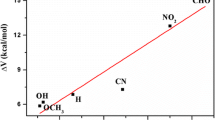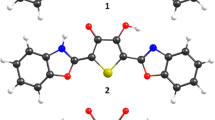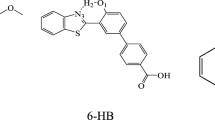Abstract
The geometry, electronic structures and potential energy profiles of protonated furan and thiophene have been extensively investigated, using the RI-MP2 and RI-CC2 methods. According to RI-CC2 calculated results, the adiabatic S1(1ππ*)–S0 transition energies of protonated furan and thiophene, have been predicted to be 4.41 eV and 3.70 eV respectively. Thus, protonation is accompanied by a large red shift effect on the first 1ππ* transition of the title systems (ΔE > 1.5 eV). The significant spectral-movements, predicted based on the calculated results of this work, indicate an essential effect of protonation on the geometry, electronic structures and optical characters of the five membered heterocyclic systems. In addition, it has been found that excitation of protonated furan and thiophene, with sufficient excess energy above the band origin of S1(1ππ*)–S0 transition, is accompanied by the S—C or O–C bond breaking. This mechanism is mostly governed by a dissociative 1πσ* PE profile in both protonated systems.
Similar content being viewed by others
References
B. H. Lipshutz, Five-membered heteroaromatic rings as intermediates in organic synthesis, Chem. Rev., 1986, 86, 795–819.
M. Klessinger and J. Michl, Excited states and photochemistry of organic molecules, New York, 1995.
J. Michl and V. Bonacic-Koutecky, Electronic aspects of organic photochemistry, Wiley-Interscience, 1990.
E. E. Rennie, C. A. F. Johnson, J. E. Parker, D. M. P. Holland, D. A. Shaw, M. A. MacDonald, M. A. Hayes and L. G. Shpinkova, A study of the spectroscopic and thermodynamic properties of furan by means of photoabsorption, photoelectron and photoion spectroscopy, Chem. Phys., 1998, 236, 365–385.
G. Buemi, F. Zuccarello and G. Romeo, Electronic spectra and excited state dipole moments of heterocyclic pentaatomic systems and their benzo and dibenzo derivatives, J. Mol. Struct., 1983, 94, 115–126.
O. Christiansen, P. Jørgensen, The electronic spectrum of furan, J. Am. Chem. Soc., 1998, 120, 3423–3430.
P. J. Derrick, L. Åsbrink, O. Edqvist, B.-Ö. Jonsson and E. Lindholm, Rydberg series in small molecules: X. Photoelectron spectroscopy and electronic structure of furan, Int. J. Mass Spectrom. Ion Phys., 1971, 6, 161–175.
W. M. Flicker, O. A. Mosher and A. Kuppermann, Electron impact investigation of electronic excitations in furan, thiophene, and pyrrole, J. Chem. Phys., 1976, 64, 1315–1321.
N. Gavrilov, S. Salzmann and C. M. Marian, Deactivation via ring opening: A quantum chemical study of the excited states of furan and comparison to thiophene, Chem. Phys., 2008, 349, 269–277.
H. Köppel, E. V. Gromov and A. B. Trofimov, Multi-mode–multi-state quantum dynamics of key five-membered heterocycles: spectroscopy and ultrafast internal conversion, Chem. Phys., 2004, 304, 35–49.
M. H. Palmer, I. C. Walker, C. C. Ballard and M. F. Guest, The electronic states of furan studied by VUV absorption, near-threshold electron energy-loss spectroscopy and ab initio multi-reference configuration interaction calculations, Chem. Phys., 1995, 192, 111–125.
J. G. Philis, Investigation of the electronic vibrational structure of furan by REMPI, Spectrochim. Acta, Part A, 2007, 67, 1357–1361.
L. W. Pickett, A Vibrational analysis of the absorption spectrum of furan in the Schumann region, J. Chem. Phys., 1940, 8, 293–297.
L. W. Pickett, N. J. Hoeflich, T.-C. Liu, The vacuum ultraviolet absorption spectra of cyclic compounds. II. Tetrahydrofuran, Tetrahydropyran, 1,4-Dioxane and Furan1, J. Am. Chem. Soc., 1951, 73, 4865–4869.
L. Serrano-Andres, M. Merchan, I. Nebot-Gil, B. O. Roos and M. Fulscher, Theoretical study of the electronic spectra of cyclopentadiene, pyrrole, and furan, J. Am. Chem. Soc., 1993, 115, 6184–6197.
K.-H. Thunemann, R. J. Buenker and W. Butscher, Configuration interaction study of the electronic spectrum of furan, Chem. Phys., 1980, 47, 313–320.
R. S. Becker, J. Seixas de Melo, A. L. Maçanita and F. Elisei, Comprehensive Evaluation of the Absorption, Photophysical, Energy Transfer, Structural, and Theoretical Properties of a-Oligothiophenes with One to Seven Rings, J. Phys. Chem., 1996, 100, 18683–18695.
H. Haberkern, K. R. Asmis, M. Allan and P. Swiderek, Triplet states in oligomeric materials: Electron energy loss spectroscopy of thiophene and bithiophene and extrapolation to the polymer, Phys. Chem. Chem. Phys., 2003, 5, 827–833.
M. Kleinschmidt, J. Tatchen and C. M. Marian, Spin-orbit coupling of DFT/MRCI wavefunctions: Method, test calculations, and application to thiophene, J. Comput. Chem., 2002, 23, 824–833.
K. Watanabe and T. Nakayama, Absorption and Photoionization Coefficients of Furan Vapor, J. Chem. Phys., 1958, 29, 48–51.
J. L. Roebber, D. P. Gerrity, R. Hemley and V. Vaida, Electronic spectrum of furan from 2200 to 1950 Å, Chem. Phys. Lett., 1980, 75, 104–106.
O. Sorkhabi, F. Qi, A. H. Rizvi and A. G. Suits, Ultraviolet photodissociation of furan probed by tunable synchrotron radiation, J. Chem. Phys., 1999, 111, 100–107.
M. Stenrup, Å. Larson, A computational study of radiationless deactivation mechanisms of furan, Chem. Phys., 2011, 379, 6–12.
E. V. Gromov, A. B. Trofimov, N. M. Vitkovskaya, H. Köppel, J. Schirmer, H.-D. Meyer and L. S. Cederbaum, Theoretical study of excitations in furan: Spectra and molecular dynamics, J. Chem. Phys., 2004, 121, 4585–4598.
H. Nakano, T. Tsuneda, T. Hashimoto and K. Hirao, Theoretical study of the excitation spectra of five-membered ring compounds: Cyclopentadiene, furan, and pyrrole, J. Chem. Phys., 1996, 104, 2312–2320.
L. Salem, Surface crossings and surface touchings in photochemistry, J. Am. Chem. Soc., 1974, 96, 3486–3501.
S. Wilsey, M. J. Bearpark, F. Bernardi, M. Olivucci and M. A. Robb, The Role of Degenerate Biradicals in the Photorearrangement of acylcyclopropenes to furans, J. Am. Chem. Soc., 1996, 118, 4469–4479.
M. H. Palmer, I. C. Walker and M. F. Guest, The electronic states of thiophene studied by optical (VUV) absorption, near-threshold electron energy-loss (EEL) spectroscopy and ab initio multi-reference configuration interaction calculations, Chem. Phys., 1999, 241, 275–296.
J. Wan, M. Hada, M. Ehara and H. Nakatsuji, Electronic excitation spectrum of thiophene studied by symmetry-adapted cluster configuration interaction method, J. Chem. Phys., 2001, 114, 842–850.
S. Salzmann, M. Kleinschmidt, J. Tatchen, R. Weinkauf and C. M. Marian, Excited states of thiophene: ring opening as deactivation mechanism, Phys. Chem. Chem. Phys., 2008, 10, 380–392.
A. Prlj, B. F. E. Curchod and C. Corminboeuf, Excited state dynamics of thiophene and bithiophene: new insights into theoretically challenging systems, Phys. Chem. Chem. Phys., 2015, 17, 14719–14730.
G. Desiraju and T. Steiner, The weak hydrogen bond in structural chemistry and biology, Oxford University Press/International Union of Crystallography, Oxford, 1990.
D. Mootz and A. Deeg, 2-Butyne and hydrogen chloride cocrystallized: solid-state geometry of Cl-H. cntdot.. cntdot.. cntdot.. pi. hydrogen bonding to the carbon–carbon triple bond, J. Am. Chem. Soc., 1992, 114, 5887–5888.
D.-M. Huang, Y.-B. Wang, L. M. Visco, F.-M. Tao, Theoretical study of stable intermolecular complexes of furan with hydrogen halides, J. Phys. Chem. A, 2004, 108, 11375–11380.
B. Saed and R. Omidyan, Electronically excited states of protonated aromatic hydrocarbons: phenanthrene and pyrene, J. Phys. Chem. A, 2013, 117, 2499–2507.
B. Saed and R. Omidyan, Protonation effect on the electronic properties of 2-pyridone monomer, dimer and its water clusters: a theoretical study, J. Chem. Phys., 2014, 140, 024315.
I. Alata, C. Dedonder, M. Broquier, E. Marceca and C. Jouvet, Role of the charge-transfer state in the electronic absorption of protonated hydrocarbon molecules, J. Am. Chem. Soc., 2010, 132, 17483–17489.
G. Grégoire, C. Jouvet, C. Dedonder and A. L. Sobolewski, Ab Initio study of the excited-state deactivation pathways of protonated tryptophan and tyrosine, J. Am. Chem. Soc., 2007, 129, 6223–6231.
I. Alata, R. Omidyan, C. Dedonder-Lardeux, M. Broquier and C. Jouvet, Electronically excited states of protonated aromatic molecules: benzaldehyde, Phys. Chem. Chem. Phys., 2009, 11, 11479–11486.
I. Alata, R. Omidyan, M. Broquier, C. Dedonder, O. Dopfer and C. Jouvet, Effect of protonation on the electronic structure of aromatic molecules: Naphthaleneh(+), Phys. Chem. Chem. Phys., 2010, 12, 14456–14458.
I. Alata, M. Broquier, C. Dedonder, C. Jouvet and E. Marceca, Electronic Excited states of protonated aromatic molecules: protonated fluorene, Chem. Phys., 2012, 393, 25–31.
I. Alata, R. Omidyan, M. Broquier, C. Dedonder and C. Jouvet, Protonated salicylaldehyde: Electronic properties, Chem. Phys., 2012, 399, 224–231.
TURBOMOLE, V6.3 2011, a development of University of Karlsruhe and Forschungszentrum Karlsruhe GmbH, 1989–2007, TURBOMOLE GmbH, since 2007; available from http://www.turbomole.com.
R. Ahlrichs, M. Bär, M. Häser, H. Horn, C. Kölmel, Electronic structure calculations on workstation computers: the program system Turbomole, Chem. Phys. Lett., 1989, 162, 165–169.
R. Ahlrichs, Efficient evaluation of three-center two-electron integrals over Gaussian functions, Phys. Chem. Chem. Phys., 2004, 6, 5119–5121.
K. Eichkorn, F. Weigend, O. Treutler and R. Ahlrichs, Auxiliary basis sets for main row atoms and transition metals and their use to approximate coulomb potentials, Theor. Chem. Acc., 1997, 97, 119–124.
F. Haase and R. Ahlrichs, Semidirect MP2 gradient evaluation on workstation computers: the mpgrad program, J. Comput. Chem., 1993, 14, 907–912.
C. Hättig, Geometry Optimizations with the coupled-cluster model cc2 using the resolution-of-the-identity approximation, J. Chem. Phys., 2003, 118, 7751–7761.
C. Hättig, A. Köhn, Transition Moments and excited-state first-order properties in the coupled-cluster model cc2 using the resolution-of-the-identity approximation, J. Chem. Phys., 2002, 117, 6939–6951.
C. Hättig and F. Weigend, CC2 Excitation energy calculations on large molecules using the resolution of the identity approximation, J. Chem. Phys., 2000, 113, 5154–5161.
T. H. Dunning, Gaussian Basis sets for use in correlated molecular calculations. i. the atoms boron through neon and hydrogen, J. Chem. Phys., 1989, 90, 1007–1023.
A. Hellweg, C. Hättig, S. Höfener and W. Klopper, Optimized accurate auxiliary basis sets for ri-mp2 and ri-cc2 calculations for the atoms Rb to Rn, Theor. Chem. Acc., 2007, 117, 587–597.
R. A. Kendall, T. H. Dunning and R. J. Harrison, Electron Affinities of the first-row atoms revisited. systematic basis sets and wave functions, J. Chem. Phys., 1992, 96, 6796–6806.
E. P. L. Hunter and S. G. Lias, Evaluated gas phase basicities and proton affinities of molecules: an update, J. Phys. Chem. Ref. Data, 1998, 27, 413–656.
S. Perun, A. L. Sobolewski and W. Domcke, Conical intersections in thymine, J. Phys. Chem. A, 2006, 110, 13238–13244.
S. Chakraborty, R. Omidyan, I. Alata, I. B. Nielsen, C. Dedonder, M. Broquier and C. Jouvet, Protonated benzene dimer: an experimental and ab initio study, J. Am. Chem. Soc., 2009, 131, 11091–11097.
G. Douberly, A. Ricks, P. v. R. Schleyer and M. Duncan, Infrared Spectroscopy of gas phase benzenium ions: protonated benzene and protonated toluene, from 750 to 3400 cm–1, J. Phys. Chem. A, 2008, 112, 4869–4874.
O. V. Boyarkin, S. R. Mercier, A. Kamariotis and T. R. Rizzo, Electronic spectroscopy of cold, protonated tryptophan and tyrosine, J. Am. Chem. Soc., 2006, 128, 2816–2817.
S. Azizkarimi, R. Omidyan and G. Azimi, Electronically excited states of protonated phenol and para-substituted phenol, Chem. Phys. Lett., 2013, 555, 19–25.
G. Cui and W. Fang, Ab Initio trajectory surface-hopping study on ultrafast deactivation process of thiophene, J. Phys. Chem. A, 2011, 115, 11544–11550.
D. Fazzi, M. Barbatti and W. Thiel, Modeling ultrafast exciton deactivation in oligothiophenes via nonadiabatic dynamics, Phys. Chem. Chem. Phys., 2015, 17, 7787–7799.
R. Weinkauf, L. Lehr, E. W. Schlag, S. Salzmann and C. M. Marian, Ultrafast dynamics in thiophene investigated by femtosecond pump probe photoelectron spectroscopy and theory, Phys. Chem. Chem. Phys., 2008, 10, 393–404.
A. J. A. Aquino, H. Lischka, C. Hättig, Excited-state intramolecular proton transfer: a survey of tddft and ri-cc2 excited-state potential energy surfaces, J. Phys. Chem. A, 2005, 109, 3201–3208.
A. J. A. Aquino, F. Plasser, M. Barbatti and H. Lischka, Ultrafast excited-state proton transfer processes: energy surfaces and on-the-fly dynamics simulations, Croat. Chem. Acta, 2009, 82, 105–113.
M. F. Rode, A. L. Sobolewski, C. Dedonder, C. Jouvet and O. Dopfer, Computational study on the photophysics of protonated benzene, J. Phys. Chem. A, 2009, 113, 5865–5873.
A. L. Sobolewski and W. Domcke, Photophysics of intramolecularly hydrogen-bonded aromatic systems: ab initio exploration of the excited-state deactivation mechanisms of salicylic acid, Phys. Chem. Chem. Phys., 2006, 8, 3410–3417.
A. L. Sobolewski and W. Domcke, Photophysics of eumelanin: ab initio studies on the electronic spectroscopy and photochemistry of 5,6-dihydroxyindole, Chem. Phys. Chem., 2007, 8, 756–762.
A. L. Sobolewski, W. Domcke, C. Hättig, Photophysics of organic photostabilizers. ab initio study of the excited-state deactivation mechanisms of 2-(2’-hydroxyphenyl)benzotriazole, J. Phys. Chem. A, 2006, 110, 6301–6306.
A. L. Sobolewski, D. Shemesh and W. Domcke, Computational studies of the photophysics of neutral and zwitterionic amino acids in an aqueous environment: Tyrosine–(H2O) 2 and Tryptophan-(H2O) 2 Clusters, J. Phys. Chem. A, 2008, 113, 542–550.
Author information
Authors and Affiliations
Corresponding author
Rights and permissions
About this article
Cite this article
Omidyan, R., Salehi, M. & Heidari, Z. A theoretical exploration on electronically excited states of protonated furan and thiophene. Photochem Photobiol Sci 14, 2261–2269 (2015). https://doi.org/10.1039/c5pp00266d
Received:
Accepted:
Published:
Issue Date:
DOI: https://doi.org/10.1039/c5pp00266d




